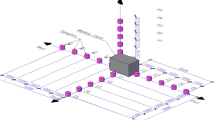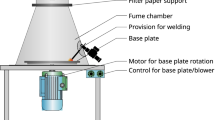Abstract
Physical and chemical properties of materials cannot be predicted only taking into account their elemental composition. Their structure is critical information to make any assessment or to understand their properties. Health risks from welding fumes are usually based on elemental composition, not the compounds they are composed of. This sometimes leads to confusion or false assessments. A review of the main compounds of arc welding fumes, or the closest ones, in terms of both elemental composition and structure, is proposed.

Similar content being viewed by others
References
EN ISO 15011-2:2009. Health and safety in welding and allied processes. Laboratory method for sampling fume and gases. Determination of the emission rates of carbon monoxide (CO), carbon dioxide (CO2), nitrogen monoxide (NO) and nitrogen dioxide (NO2) during arc welding, cutting and gouging
EN ISO 15011-3:2009. Health and safety in welding and allied processes. Laboratory method for sampling fume and gases. Determination of ozone emission rate during arc welding
EN ISO 15011-5:2011. Health and safety in welding and allied processes. Laboratory method for sampling fume and gases. Identification of thermal-degradation products generated when welding or cutting through products composed wholly or partly of organic materials using pyrolysis-gas chromatography-mass spectrometry
Zimmer AT, Biswas P (2001) Characterization of the aerosols resulting from arc welding processes. J Aerosol Sci Aug 32(8):993–1008. https://doi.org/10.1016/S0021-8502(01)00035-0
Moroni B, Viti C (2009) Grain size, chemistry, and structure of fine and ultrafine particles in stainless steel welding fumes. J Aerosol Sci 40(11):938–949. https://doi.org/10.1016/j.jaerosci.2009.08.004
Dasch J, D’Arcy J (2008) Physical and chemical characterization of airborne particles from welding operations in automotive plants. J Occup Environ Hyg 5(7):444–454. https://doi.org/10.1080/15459620802122720
Oprya M, Kiro S, Worobiec A, Horemans B, Darchuk L, Novakovic V, Ennan A, VanGrieken R (2012) Size distribution and chemical properties of welding fumes of inhalable particles. J Aerosol Sci 45:50–57. https://doi.org/10.1016/j.jaerosci.2011.10.004
Jenkins NT, Pierce WM-G, Eagar TW (2005) Particle size distribution of gas metal and flux cored arc welding fumes. Welding J 84:156s–163s
EN ISO 15011-1:2009. Health and safety in welding and allied processes. Laboratory method for sampling fume and gases. Determination of fume emission rate during arc welding and collection of fume for analysis
INRS (2012) ED 6132 Les fumées de soudage et des techniques connexes. http://www.inrs.fr/dms/inrs/CataloguePapier/ED/TI-ED-6132/ed6132.pdf
Manitoba Labour Workplace Safety and Health (2000) Welding guideline
Human Ressources and Social Development Canada A guide to health hazards and hazard control measures with respect to welding and allied processes. http://www12.esdc.gc.ca/sgpe-pmps/servlet/sgpp-pmps-pub?lang=eng&curjsp=p.5bd.2t.1.3ls@-eng.jsp&curactn=dwnld&pid=3234&did=1&_ga=1.263763660.1313083678.1489589353
Heile RF, Hill DC (1975) Particulate fume generation in arc welding processes. Welding Journal 54(7):201s–210s
Kobayashi M, Maki S, Hashimoto Y, Suga T (1978) Some considerations about formation mechanism of welding fumes. Welding in the World 16(11/12):238–249
Gray C.N., Hewitt P.J., Dare P.R.M. (1982) New approach would help control welding fumes at source (MIG and MMA) part two: MIG fumes. Welding and Fabrication October, 393–397
Jenkins NT, Eagar TW (2005) Chemical analysis of welding fume particles. Welding Journal 84(6):87s–93s
Kobayashi M. and Tsutsumi S. (1986) Investigation on crystalline materials in welding fumes of covered electrodes, , Proceedings of the International Conference on Health Hazards and Biological Effects of Welding Fumes and Gases, eds. R. M. Stern, A. Berlin, A. Fletcher, K. Hemminki, J. Jarvisalo and J. Peto, pp. 77–80,Amsterdam, Excerpta Medica
Kimura S, Kobayashi M, Godai T, Minato S (1979) Investigations on chromium in stainless steel welding fumes. Welding Journal 58(7):195s–204s
Voitkevich V (1995) Formation, Properties and Biological Effects. Abington Publishing, Cambridge, England
Sowards JW, Lippold JC, Dickinson DW, Ramirez AJ (2008) Characterization of welding fume from SMAW electrodes—part I. Size and mass distributions, fumegeneration rates, and chemistry are compared for three SMAW electrodes. Weld J 87:106s
Sowards JW, Ramirez AJ, Dickinson DW, Lippold JC (2010) Characterization of welding fume from SMAW electrodes—part II. Weld J 89(4):82s–90s
Carpenter KR, Monaghan BJ, Norrish J (2009) Analysis of fume formation rate and fume particle composition for gas metal arc welding (GMAW) of plain carbon steel using different shielding gas compositions. ISIJ Int 49(3):416–420. https://doi.org/10.2355/isijinternational.49.416
Minni E et al (1984) A study of the chemical structure of particles in the welding fumes of mild and stainless steel. Journal of Aerosol Science 15(1):57–68. https://doi.org/10.1016/0021-8502(84)90056-9
Koponen M, Gustafsson T, Kalliomaki PL, Pyy L (1981) Chromium and nickel aerosols in stainless steel manufacturing, grinding and welding. Am Ind Hyg Assoc J 42(8):596–601
Guillemet-Fritsch S, Navrotsky A, Tailhades P, Coradin H, Miaojun WM (2005) Thermochemistry of iron manganese oxide spinels. J Solid State Chem 178:106–113
Gonser MJ, Lippold JC, Dickinson DW, Sowards JW, Ramirez AJ (2010) Characterization of welding fume generated by high-Mn consumables. Welding Journal 89(2):25s–33s
Keane M, Stone S, Chen B (2010) Welding fumes from stainless steel gas metal arc processes contain multiple manganese chemical species. J Environ Monit 12(5):1133–1140. https://doi.org/10.1039/B922840C
Maynard AD, Ito Y, Arslan I, Zimmer AT, Browning N, Nicholls A (2004) Examining elemental surface enrichment in ultrafine aerosol particles using analytical scanning transmission electron microscopy. Aerosol Sci Technol 38(4):365–381
Acknowledgements
The author would like to thank the Commission VIII members for their comments and insights.
Author information
Authors and Affiliations
Corresponding author
Additional information
Recommended for publication by Commission VIII - Health, Safety, and Environment
Rights and permissions
About this article
Cite this article
Floros, N. Welding fume main compounds and structure. Weld World 62, 311–316 (2018). https://doi.org/10.1007/s40194-018-0552-3
Received:
Accepted:
Published:
Issue Date:
DOI: https://doi.org/10.1007/s40194-018-0552-3




